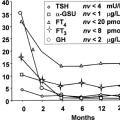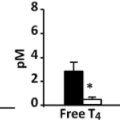Myxedema Coma
Leonard Wartofsky
Myxedema coma is severe, life-threatening hypothyroidism. It was probably first reported in 1879 by Ord from the St. Thomas Hospital, London. Two of the 12 patients with fatal hypothyroidism described in a report of the Clinical Society of London in 1888 appeared to have died in coma (1). Remarkably, the next cases did not appear in the literature until 1953 (2,3), and about 200 cases have been reported subsequently. Additional references may be obtained from earlier reviews (4).
Table 44.1 Myxedema Coma: Precipitating and Exacerbating Factors | |||||||||||||||||||
|---|---|---|---|---|---|---|---|---|---|---|---|---|---|---|---|---|---|---|---|
|
Most patients with myxedema coma are elderly women with long-standing hypothyroidism, and who therefore usually have characteristic clinical manifestations of hypothyroidism. Once
considered, the diagnosis should be easy to establish on the basis of both clinical and laboratory findings; despite vigorous therapy, the mortality rate may be high.
considered, the diagnosis should be easy to establish on the basis of both clinical and laboratory findings; despite vigorous therapy, the mortality rate may be high.
Clinical Features: Precipitating Events
Myxedema coma is more likely to occur in winter than in summer, suggesting that low environmental temperature may somehow precipitate the syndrome, and hypothermia is a cardinal clinical finding. Other events that may trigger the onset of myxedema coma include pulmonary and other infections, cerebrovascular accidents, and congestive heart failure (Table 44.1) Pulmonary infection may occur as a secondary event because of hypoventilation due to somnolence, as can aspiration pneumonia. Similarly, it may be difficult to determine whether other abnormalities, such as hypoglycemia, hyponatremia, hypoxemia, and hypercapnia, which often are present in patients with myxedema coma, contributed to the onset of the coma or are consequences of it. In other patients, sedative, analgesic, antidepressant, hypnotic, antipsychotic, and anesthetic drugs have been incriminated as precipitating or exacerbating myxedema coma because of their ability to depress respiration. Drug-induced myxedema coma is particularly likely to occur in hospitalized patients because these types of drugs are more likely to be dispensed there than outside of the hospital, and the patients are typically not known to have hypothyroidism.
General Description
Most patients with myxedema coma have had symptoms of hypothyroidism for many months, and the onset of stupor or coma is precipitated by cold exposure, infection, or other systemic disease, or by drugs, as noted above. There may be a past history of antecedent thyroid disease, thyroid hormone therapy that was discontinued for no apparent reason, or radioiodine therapy. Examination of the neck may reveal a surgical scar and no palpable thyroid tissue or goiter.
A survey of hospitals in Germany (1993 to 1995) identified 24 patients with myxedema coma, probably the largest number ever analyzed together, although the authors reclassified 12 patients as having severe hypothyroidism but not coma (5). Of those with coma, approximately 5% had hypothalamic or pituitary disease as the cause of their hypothyroidism. The mean age of the 24 patients (20 women, 4 men) was 73 years. Twenty-three had primary hypothyroidism and one central hypothyroidism; nine were known to have hypothyroidism before the episode of coma. With respect to clinical findings, 80% had hypoxemia, 54% had hypercapnia, and 21 had a temperature less than 94°F. All received some thyroid hormone therapy, and six (25%) died.
The course often is one of lethargy progressing to stupor and then coma, with respiratory failure and hypothermia, all of which may be hastened by the administration of drugs that depress respiration and other central nervous system (CNS) functions. Most patients have the characteristic features of severe hypothyroidism, such as dry, coarse, and scaly skin; sparse or coarse hair; nonpitting edema (myxedema) of the periorbital regions, hands, and feet; macroglossia; hoarseness; and delayed deep-tendon reflexes. Moderate to profound hypothermia is common.
Hypothermia
Hypothermia is present in about three-fourths of patients. It may be dramatic (<80°F), and it may be the first clinical clue to the diagnosis of myxedema coma. Conversely, the diagnosis should be considered seriously in any unconscious patient with an infection who does not have fever. There is a correlation of survival with presenting body temperature, with patients having core temperatures below 90°F having the poorest prognosis (6). Hypoglycemia may decrease body temperature further. It is fortunate that old-style mercury thermometers are rarely used today (at least in the USA) because the degree of hypothermia may be underestimated if the mercury column has not been lowered to well below normal before the patient’s temperature is measured. Moreover, these thermometers do not record below 94°F, and therefore the degree of hypothermia may be underestimated. Electronic thermometers record temperature over a much wider range.
Respiratory System
Respiratory depression, common in patients with myxedema coma, is caused by decreased hypoxic respiratory drive and a decreased ventilatory response to hypercapnia (7) (see Chapters 39 and 40) The resulting alveolar hypoventilation leads to progressive hypoxemia, and ultimately to CO2 narcosis and coma. Impaired respiratory muscle function and obesity may exacerbate the hypoventilation (8,9). With respect to coma, the principal factor seems to be a depressed respiratory center response to CO2. Whether attributable to central respiratory depression or to respiratory muscle dysfunction, hypoventilation is sufficiently severe in most patients with myxedema coma to require mechanically assisted ventilation. Other factors that may impair respiration in severely hypothyroid patients include
pleural effusions or ascites, by reducing lung volume, and macroglossia and myxedema of the nasopharynx and larynx by reducing the lumen of the airway. Recovery from respiratory failure may be slow despite apparently adequate therapy. The occurrence of pneumonitis as a precipitating factor for respiratory decompensation and myxedema coma may be related to a predisposition in hypothyroidism to airway hyperresponsiveness and chronic inflammation (10).
pleural effusions or ascites, by reducing lung volume, and macroglossia and myxedema of the nasopharynx and larynx by reducing the lumen of the airway. Recovery from respiratory failure may be slow despite apparently adequate therapy. The occurrence of pneumonitis as a precipitating factor for respiratory decompensation and myxedema coma may be related to a predisposition in hypothyroidism to airway hyperresponsiveness and chronic inflammation (10).
Cardiovascular Manifestations
The findings considered typical of hypothyroid heart disease also are found in myxedema coma and include cardiac enlargement, decreased cardiac contractility, and nonspecific electrocardiographic abnormalities (see Chapter 40). Although bradycardia tends to be universally present, occasional patients may present with torsades de pointe ventricular tachycardia (11). The cardiac enlargement may be due to either ventricular dilatation or pericardial effusion. The decrease in cardiac contractility results in a low stroke volume and low cardiac output, but frank congestive heart failure is rare.
Patients with myxedema coma may have hypotension because of decreased intravascular volume, and cardiovascular collapse and shock may occur late in the course. If at all, the latter characteristically responds only when both a vasopressor drug such as dopamine and thyroid hormone are given. Myocardial infarction may be somewhat more difficult to rule out due to low voltage on EKG, particularly in the presence of pericardial effusion. Moreover, hypothyroidism alters the LDH isoenzyme pattern and elevates total CPK levels although most of the elevation is in the MM band (from skeletal muscle).
Gastrointestinal Manifestations
A neurogenic oropharyngeal dysphagia has been described that is associated with delayed swallowing and may account for the predisposition to aspiration and risk of aspiration pneumonia (12). Decreased intestinal motility is common in hypothyroidism, and its most severe manifestations, paralytic ileus and megacolon, can occur in patients with myxedema coma. Thus, many patients have anorexia, nausea, abdominal pain, constipation, and a distended, quiet abdomen, and ascites is quite common (13). Gastric atony also occurs (14) and can be a particularly troublesome problem because it may serve to reduce absorption of oral medications.
Renal and Electrolyte Manifestations
Hyponatremia and a decreased glomerular filtration rate are rather consistent findings among patients with myxedema coma (15). The hyponatremia is due to the inability to excrete a water load, caused both by decreased delivery of water to the distal nephron and excess vasopressin secretion (see Chapter 39). Urinary sodium excretion is normal or increased, urinary osmolality is high relative to plasma osmolality, and there may be bladder atony, with urinary retention. Hyponatremia alone may cause lethargy and confusion, and it undoubtedly contributes further to these problems in patients who have them as a result of hypothyroidism.
Neuropsychiatric Manifestations
Just as is seen in other patients with hypothyroidism see Chapter 43, patients with myxedema coma may have a history of lethargy, slowed mentation, poor memory, cognitive dysfunction, depression, or even psychosis. They do not complain of these symptoms, however, because of their impaired state of consciousness. Up to 25% of patients with myxedema coma have focal or generalized seizures caused by CNS dysfunction per se, hyponatremia, or hypoxemia resulting from decreased cerebral blood flow (16).
Stay updated, free articles. Join our Telegram channel

Full access? Get Clinical Tree








